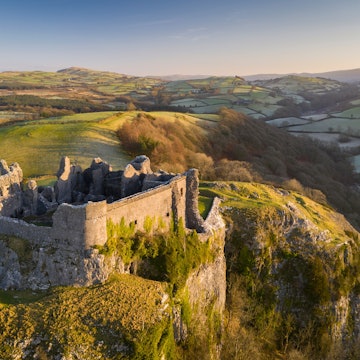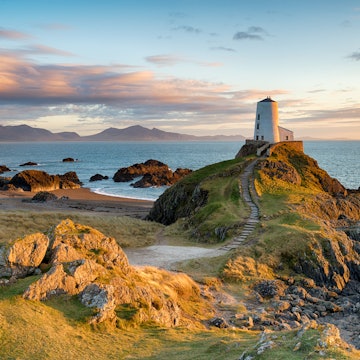
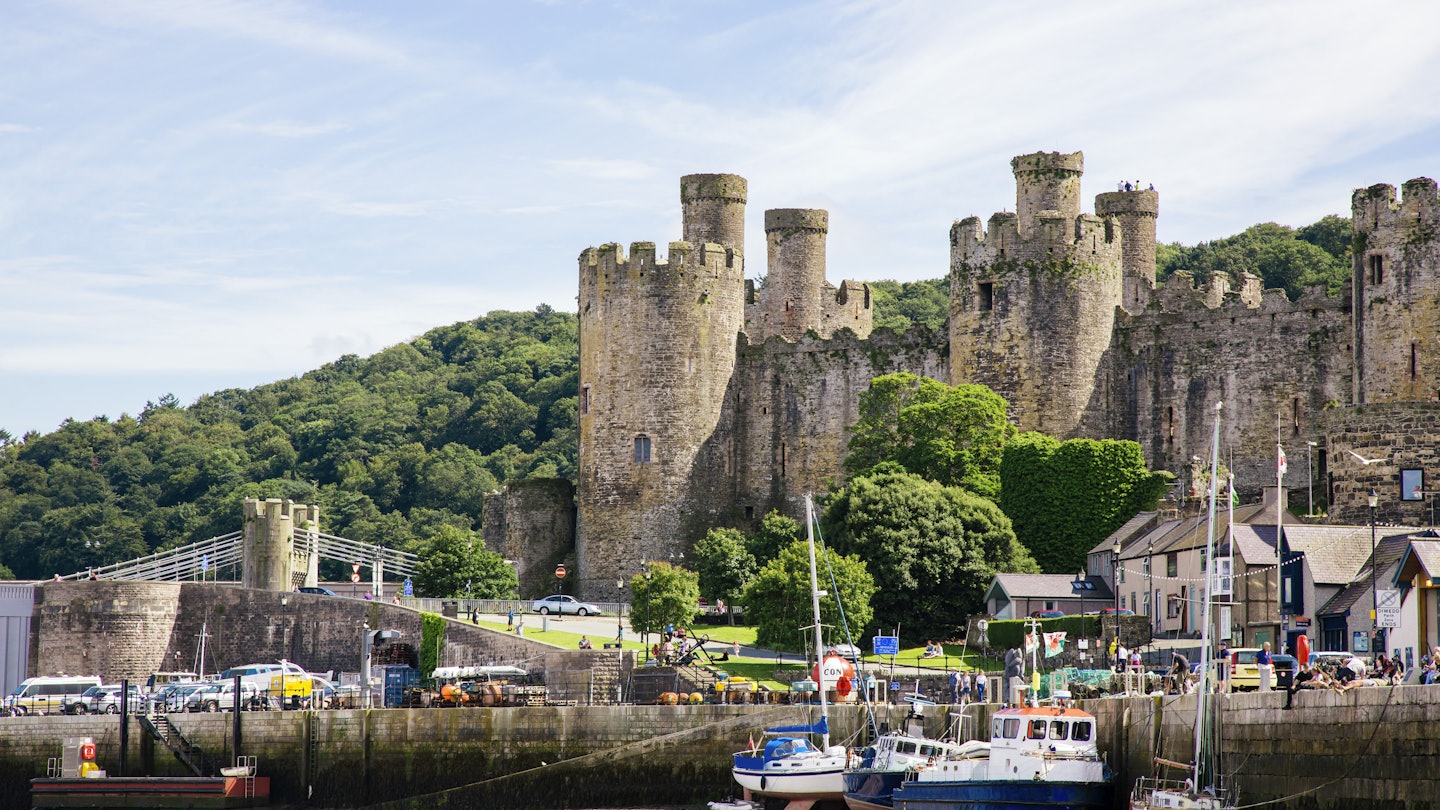
Conwy has one of the best-preserved medieval fortifications in Britain. Alexander Spatari/Getty Images
The town of Conwy is home to the 13th-century Conwy Castle, constructed by King Edward I on his ruthless conquest tour of North Wales. Built in less than four years, the castle and surrounding walls still tower over the town some seven centuries later.
The castle is part of the UNESCO-listed “Castles and Town Walls of King Edward in Gwynedd," which also includes Beaumaris, Caernarfon and Harlech castles. Stretching over three-quarters of a mile (1.3km), Conwy's defensive walls weren’t just built for show; take a walk along them to view the medieval town from up high.
Spend the day visiting Conwy Castle and its historic surroundings with this comprehensive guide.

When should I go to Conwy Castle?
Although Conwy Castle is Wales’ most visited historic sight – on a par with nearby Caernarfon Castle – you'll find there is plenty of room to roam in this well-preserved castle. If you want to avoid the crowds, the busiest times are at Easter, summer weekends and during school holidays. If you come at any of these times, arrive in the early morning or late afternoon for the best experience.
Travelers with children should check online for details about special school holiday events at the castle for kids. From archery to entertainment from medieval court jesters, or a Welsh storyteller regaling visitors with ancient tales, there are plenty of reasons to plan your visit ahead.
The best season to visit is in spring (March to May) or autumn (September to November). If you’re lucky, you may arrive in time for the Conwy Seed Fair or the Conwy Honey Fair, when the town gets busy with producers from across the country.
How much time should I spend at Conwy Castle?
The castle itself needs at least two hours, depending on your level of interest in British history, court life, rebellion and political intrigue. Allocating three hours is not unreasonable. However, if you're in a huge hurry or are cajoling unwilling companions, you could whip through and glean some of the fascinating history of the castle in an hour.
Two hours will give you enough time to see the Great Hall, the Chapel and the King’s Apartments, explore the castle's nooks and crannies, walk the castle walls, and climb its fortified towers for incredible views over the Conwy Estuary and Conwy quayside.
If time and budget allow, consider booking a tour with a local outfit such as Conwy History to enhance your experience.

How much do tickets cost?
Admission to the castle costs around £13 (US$17.40) for an adult, £9 (US$12) for a child, or £42 (US$56.20) for a family. However, if you’re visiting another castle run by Cadw in the area, you can get a multi-location ticket for just a little extra, saving you on further admission fees.
The last admission is 30 minutes before closing, but that won’t allow you much time to see the views over Conwy, or much of the castle, so definitely don’t leave it until the last minute. In the summer, the castle is open from 9:30am until 5pm. Opening hours are shorter (10am to 4pm) from November to February.
There’s usually no need to book ahead, unless you’re on a very specific schedule. However, pre-purchasing your tickets online does get you a 5% discount. Prices are also a little lower outside the peak season (you pay less to enter from September to March). Note that Conwy Castle is closed from December 24 to 26 and on January 1.
How do I get there?
If you’re coming by car, there isn’t a car park at the site itself. Local council-managed car parks are dotted around town, or on the outskirts of Conwy, from where you’ll need to walk into the town. There is a train station servicing the town, only a few hundred meters from the castle entrance. Buses will also take you between Conwy and Caernarfon, Bangor or Llandudno.
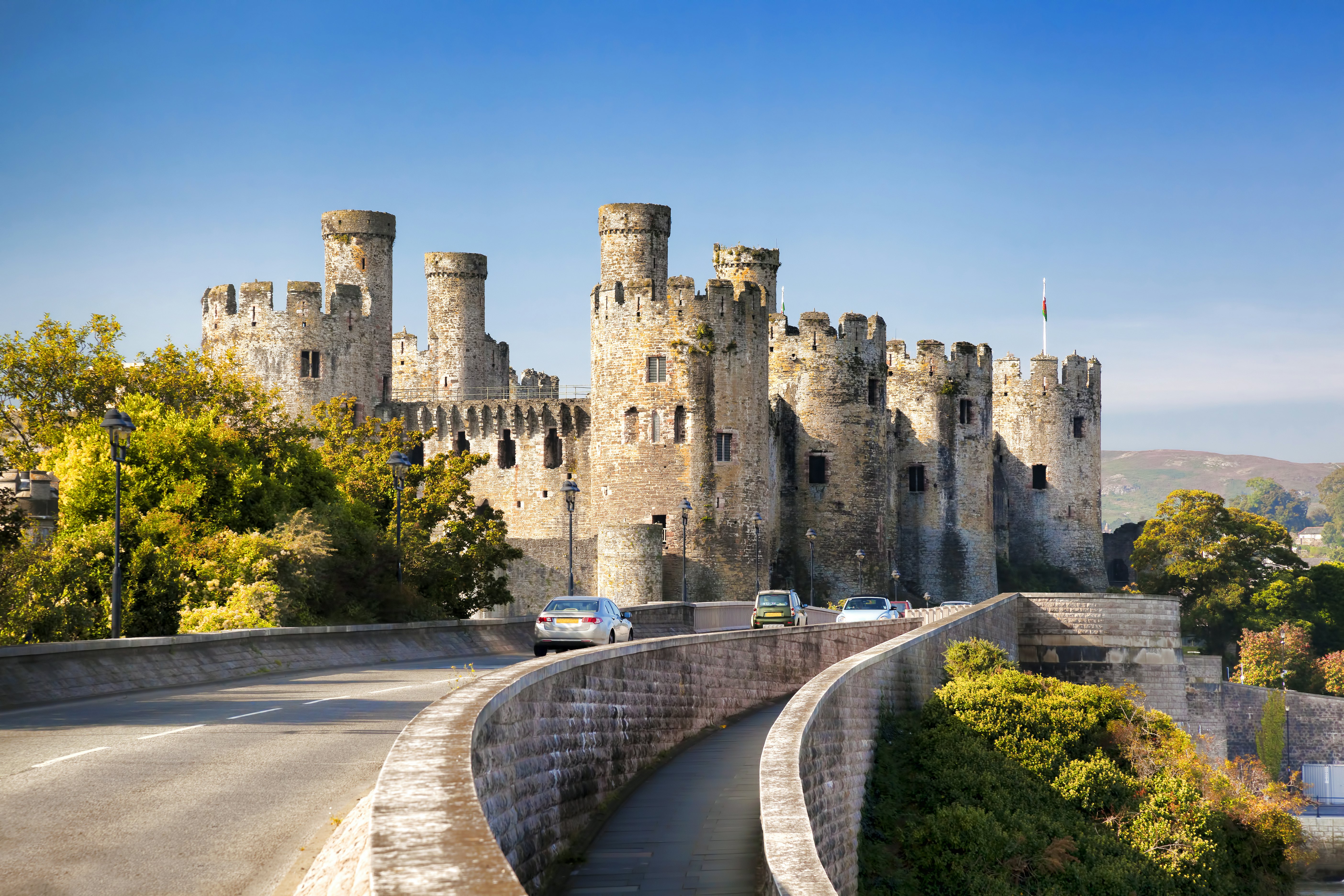
How to explore Conwy Castle and the surrounding town
Soak up the history of Conwy Castle
Conwy Castle was part of King Edward I's "iron ring" of fortresses, designed to maintain English control over the newly conquered Welsh territories. It was both a defensive stronghold and a royal residence, symbolizing English dominance in North Wales, though that didn’t go so well for Edward.
The thick curtain walls and eight soaring towers hint at the grandeur and strategic brilliance inside. Wander through the remarkably well-preserved rooms and battlements, and you can almost hear the clank of armor and the devious whispers of scheming lords and dukes from across the centuries.
Be sure to sneak through servants’ passages between the rooms and take a tour of the suite of royal apartments, which were barely lived in thanks to the raucous Welsh rebellion, led by Madog ap Llywelyn in 1294.
For epic views, ascend narrow spiral staircases to the top of the battlements, where you can look out over the wide Conwy Estuary and the town, snug within its original 700-year-old walls.
Walk the town wall
Thanks to its 1.3km-long (0.75-mile) town wall, built concurrently with the castle, Conwy is one of the UK’s prime medieval sites. The 9m-tall (30ft) wall, punctuated by 21 horseshoe towers, was erected to protect the English colonists from the Welsh locals, who were forbidden to live in the town and even banned from the surrounding countryside.
You can enter the town wall at Rose Hill St and walk along the battlements to admire the views. The Porth yr Arden to Porth Uchaf section is particularly picturesque.
Take a boat trip on the Conwy Estuary
Cruises around the Conwy Estuary and the riverside quay at Trefriw have long been a tourist highlight, with river steamers transporting visitors and local workers since 1847. Head to the marina for all-weather boat tours, heading both inland from Conwy, and downriver towards the wildlife-rich Irish Sea.
As you meander along the river, you'll be treated to views of the castle towering over the town, its stone walls and towers cutting an impressive figure against the coastal landscape. Look out for cormorants and grey herons along the banks or, if lucky, the odd seal popping up for a quick hello.
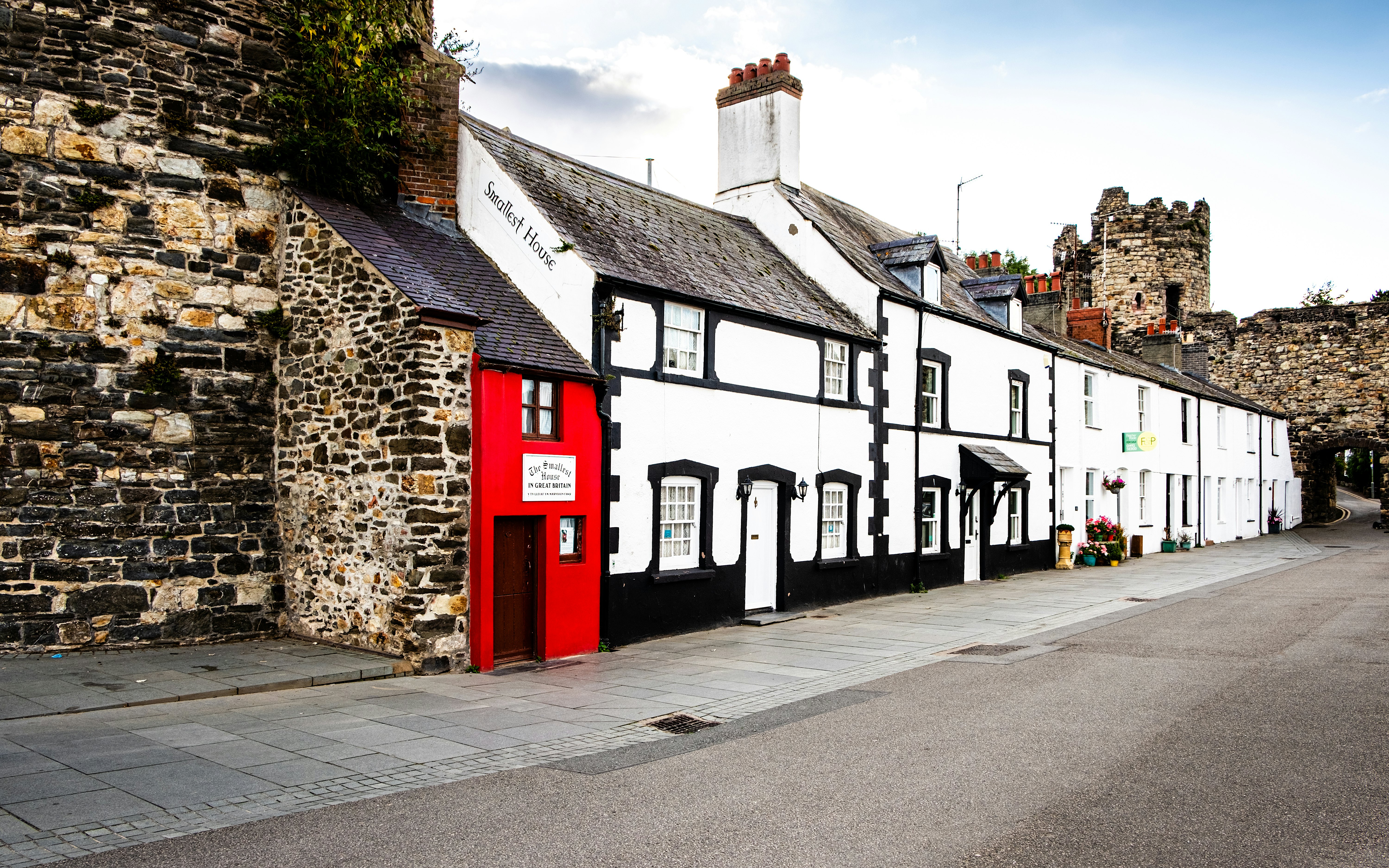
Visit the Smallest House in Great Britain
Located on Conwy quay by the castle is a tiny red house with barely room to swing a cat. Its bedroom and living room fit into a compact space measuring just over 3m (9.8ft) high and 1.8m (5.9ft) across, earning it a mention from Guinness World Records.
Believe it or not, back in 1900, its last resident was a local fisherman who was 6ft 3in (1.91m) in height, and had a rather cramped time of it!
See how the other half lived at Plas Mawr
Just a five-minute walk from Conwy Castle is another historic sight that is well worth a visit. Plas Mawr is arguably Britain's finest surviving Elizabethan townhouse. Purchased in 1576 by one of the first Welshmen to live in Conwy – Robert Wynn, merchant and diplomat in the royal courts of Europe – this discreet whitewashed building hides a vivid interior.
Plas Mawr is noteworthy for its colorful friezes, heraldic devices bearing the initials of the owner, and superb plasterwork that emphasizes the noble Wynn dynasty and the owner's descent from the Princess of Gwynedd. The exhibition on 16th-century hygiene will raise eyebrows.
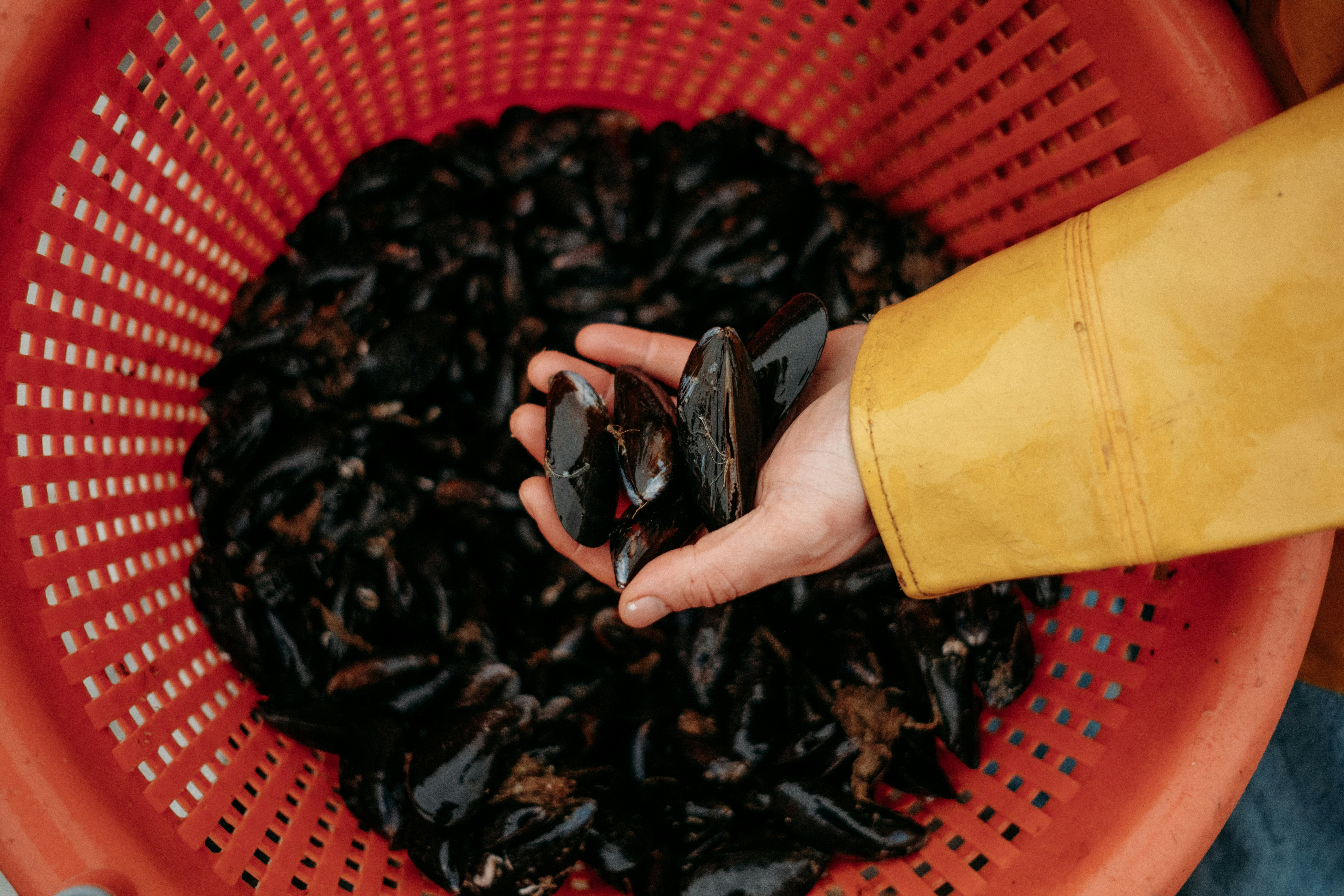
Where should I eat or drink in Conwy?
Get breakfast or lunch at Upstairs at Anna’s for the photogenic interior and attractively plated dishes, as well as the flavors. As evening approaches, there are plenty of characterful historic pubs in Conwy for a hearty pub dinner. The Erskine Arms features open fires, leather armchairs, and a gastropub-style menu. The Blue Bell Historic pub has a selection of vegan street food, a quirky interior and a beer garden; it also hosts live music and open-mic nights.
Fish and chips is another classic seaside meal, with a host of good options on the high street. If you’re self-catering, buy fresh, locally farmed Conwy mussels from Conwy Mussels Co on the historic quayside and steam them with butter, garlic and white wine back at your accommodation. You can also purchase dressed crabs and scallops for a proper seafood feast.
Where should I stay?
If you’re on a budget, head for the YHA Conwy, which is just outside Conwy's historic walls and has panoramic views of the castle and mountains. The hostel has a good mix of dorms, private rooms and bell tents in the summer.
At the other end of the spectrum, overlooking the Deganwy Marina, the Quay Hotel & Spa features a swanky wellness suite, an indoor swimming pool, and an ambient bar for cocktails by the sea. The rooms are modern with a coastal vibe to the decor.
Is Conwy Castle accessible?
Due to its age and structure, most of Conwy Castle is not accessible to those with limited mobility. The site includes steep paths, stairs and uneven surfaces such as cobblestone paths. The Cadw website provides more information for visitors, as well as virtual tours.
This article was adapted from Lonely Planet’s Wales guidebook, published in June 2025.











